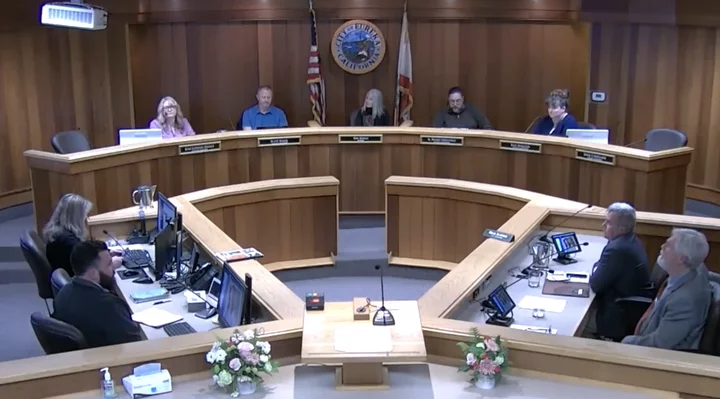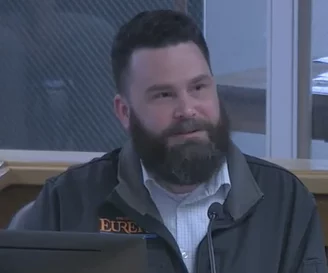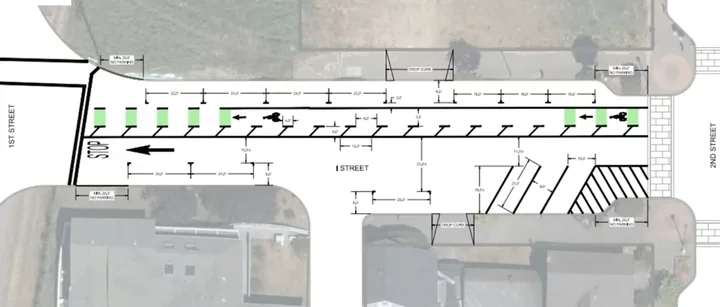Screenshot of Tuesday’s Eureka Council meeting.
###
At last night’s regular meeting, the Eureka City Council received a progress report on city’s Homeless Action Plan and staff’s ongoing efforts to address one of the community’s most pressing issues.
The plan includes eight goals to reduce homelessness in Eureka by increasing access to affordable housing and expanding the city’s homeless prevention program. The plan also seeks to increase engagement with people experiencing homelessness through partnerships and collaborations with service providers and local organizations.
What has been accomplished so far? According to city staff: Quite a bit, actually! Jeff Davis, project manager for the Community Access Project for Eureka (CAPE) and UPLIFT Eureka, said his team has helped rehouse 56 individuals through UPLIFT’s Rapid Rehousing program since the Homeless Action Plan was approved in 2022.
“Fifty-six is a lot because these folks are the ones that have the highest needs [and] are the most vulnerable,” Davis said. “It’s not just securing housing and helping folks move in – it’s providing those supportive services [to] ensure that they’re able to stabilize [and get] connected with services and keep that housing permanently. We are continuing to reach out to landlords and trying to house as many folks as possible.”
UPLIFT has rehoused over 200 people since it launched its Rapid Rehousing program in 2019, he added.
At the beginning of this year, Eureka received a “prohousing” designation from Gov. Gavin Newsom’s Office, paving the way for more funding opportunities for future housing projects. Davis said the city is working with private developers to build “over 300 deed-restricted affordable housing units” across several city-owned properties by 2028.
Staff has made significant progress with the Crowley property, Davis continued, referring to a transitional housing project on Hilfiker Lane, near the Hikshari Trail at the south end of town.
“We are moving forward with the assembling transitional housing units … and we’re making progress every week,” he said. The city will receive the final shipment of “wet units,” including bathrooms, showers and laundry facilities, next month. “If we continue this progress, there’ll be a potential moving date of July or August of this year. And that’s enough [space] for up to 40 individuals that are currently living in camps along the Waterfront Trail here in Eureka.”
Shifting to engagement and outreach goals, Davis said UPLIFT and the city’s Community Safety Engagement Team (CSET) have been working with local service providers and the county to survey people experiencing homelessness. The biennial Point-In-Time (PIT) Count was conducted at the beginning of this year but the data has yet to be finalized, Davis said.
“Those numbers should be available pretty soon,” he said. “We analyze and apply that data to our outreach and our different programs.”
In just a few months, the city will open a resource center on the E Street side of the Eureka Municipal Auditorium. Davis said the resource center should be up and running in early July. “It’ll be a wonderful place for folks to go and community members come and [get] connected with resources and services,” he said. “Progress is being made every day.”
The city has also “stepped up” its low-barrier, overnight shelter options, Davis said. In partnership with faith-based organizations, the city expanded its extreme weather overnight warming center, providing “low- to no-barrier” shelter for people needing a place to sleep. “We activated [the shelter] last year multiple times and it was a great success,” he said.
Following Davis’ presentation, Councilmember Scott Bauer asked if there was a waiting list for homeless folks seeking housing. There are over 900 people in the county’s “coordinated entry system,” which is more of an eligibility list than a waiting list, Davis said.
“Just so we’re clear, when we say ‘900’ that’s by the McKinney-Vento definition of homeless,” City Manager Miles Slattery added. “[They’re] not necessarily unsheltered; [that] could be people living in hotels, people living on couches … .”
Councilmember Leslie Castellano asked if the staff had made any progress in establishing a sanctioned camping area in the city. Slattery said the city held a workshop last year to gauge interest in an authorized encampment. Staff connected with an individual interested in facilitating an encampment, but the conversation fizzled out.
Councilmember Renee Contreras-DeLoach thanked city staff for their dedication. “It’s inspiring,” she said. “I think it’s really impressive because some of the stuff that the city is doing is not [stuff] that the city has to do, but it’s stuff that is being done.”
Mayor Kim Bergel echoed Contreras-DeLoach’s sentiments and urged people to pay attention to the important work staff is doing. “A lot of good things are happening in our city, and you find what you look for.”
The council did not take any action on the report.
More Construction Along H and I Streets
The city council approved staff’s request to reduce traffic from one two lanes to two one lane on H and I Streets (both one-ways) between 1st and 2nd Streets in Old Town to make way for a buffered bike lane, plus a few more parking spaces, as seen in the graphic below.
A diagram of the proposed lane configuration on I Street. The northernmost lane would be removed to accommodate a buffered bike lane. | Screenshot
The project follows the city’s Complete and Green Streets Policy, which aims to create a “comprehensive, connected multimodal transportation network that contributes directly to the safety, health, economic vitality and quality of life of all residents, especially the most vulnerable.” In this case, the city is hoping to create a corridor that safely connects Old Town to Henderson Center neighborhoods, said City Engineer Jesse Willor.
Councilmember Kati Moulton asked if the bike lane would stay on the same side of the street from Old Town all the way to Henderson Center. Willor said the bike lane would actually shift from one side of the road to the other between 2nd and 3rd Streets.
“We wouldn’t do it at the busiest intersections in town,” he said. “[There’s] much lower volume of traffic down there on 2nd and 3rd, and it would just be one crossing. … Because of the way the parking and everything’s configured down there, you have to move [the bike lane] or else you’d have to go down and reconfigure all the parking between 4th and 1st, or at least some of it, in order to make it work.”
Bauer asked if the realignment of parking spaces would result in a loss of parking. By shifting from diagonal to parallel parking, Willor said the project would actually add four spaces to Old Town.
One public commenter asked if the staff would consider people towing trailers and boats while implementing the project, adding that he’s had a difficult time getting around the newly constructed bulb-outs without veering into oncoming traffic. “I just got ran off the road this morning by a Mercer-Fraser concrete truck, so just keep that in mind when you guys are planning, please,” he said.
Colin Fiske, executive director of the Coalition for Responsible Transportation Priorities, spoke in favor of the project, noting that it is “an important part of connecting the Waterfront Trail and facilities in that part of town with the rest of town.”
After a bit of additional discussion, Moulton made a motion to approve the resolution, which was seconded by Councilmember G. Mario Fernandez. The motion was approved in a 4-1 vote, with Contreras-DeLoach dissenting.
###
Odds and ends from Tuesday’s meeting:
- Mayor Kim Bergel invited meeting attendees to the upcoming community health town hall – “Embracing Humanity” – featuring keynote speaker Joe Roberts aka the “Skidrow CEO.” The event will take place at Eureka City Hall on Saturday, May 4, from 10 a.m. to 4 p.m. “If we fill the room to capacity, Miles [Slattery] will buy me a car!” Bergel said. “So everybody please come and bring all your friends!” More information on the town hall can be found at this link.
- The city council unanimously approved the creation of the Eureka Housing Trust Fund to support various city-operated housing development programs, including the city’s accessory dwelling unit (ADU) program. Last year, the city earmarked $500,000 in American Rescue Plan Act (ARPA) funds to start the trust. The city will contribute at least $100,000 in Vacation Dwelling Unit (VDU) Transient Occupancy Tax (TOT) revenues to the trust fund each year.
- Mayor Bergel also noted that the floral arrangements on either side of the speakers’ podium were made by students in the Eureka High School floral program. How nice!
###
A recording of the meeting can be found here.



CLICK TO MANAGE